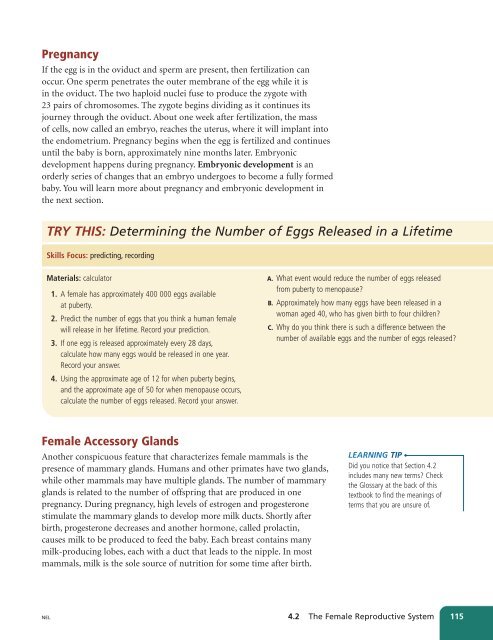Unit A Reproduction
Unit A Reproduction
Unit A Reproduction
You also want an ePaper? Increase the reach of your titles
YUMPU automatically turns print PDFs into web optimized ePapers that Google loves.
Pregnancy<br />
If the egg is in the oviduct and sperm are present, then fertilization can<br />
occur. One sperm penetrates the outer membrane of the egg while it is<br />
in the oviduct. The two haploid nuclei fuse to produce the zygote with<br />
23 pairs of chromosomes. The zygote begins dividing as it continues its<br />
journey through the oviduct. About one week after fertilization, the mass<br />
of cells, now called an embryo, reaches the uterus, where it will implant into<br />
the endometrium. Pregnancy begins when the egg is fertilized and continues<br />
until the baby is born, approximately nine months later. Embryonic<br />
development happens during pregnancy. Embryonic development is an<br />
orderly series of changes that an embryo undergoes to become a fully formed<br />
baby. You will learn more about pregnancy and embryonic development in<br />
the next section.<br />
TRY THIS: Determining the Number of Eggs Released in a Lifetime<br />
Skills Focus: predicting, recording<br />
Materials: calculator<br />
1. A female has approximately 400 000 eggs available<br />
at puberty.<br />
2. Predict the number of eggs that you think a human female<br />
will release in her lifetime. Record your prediction.<br />
3. If one egg is released approximately every 28 days,<br />
calculate how many eggs would be released in one year.<br />
Record your answer.<br />
4. Using the approximate age of 12 for when puberty begins,<br />
and the approximate age of 50 for when menopause occurs,<br />
calculate the number of eggs released. Record your answer.<br />
A. What event would reduce the number of eggs released<br />
from puberty to menopause?<br />
B. Approximately how many eggs have been released in a<br />
woman aged 40, who has given birth to four children?<br />
C. Why do you think there is such a difference between the<br />
number of available eggs and the number of eggs released?<br />
Female Accessory Glands<br />
Another conspicuous feature that characterizes female mammals is the<br />
presence of mammary glands. Humans and other primates have two glands,<br />
while other mammals may have multiple glands. The number of mammary<br />
glands is related to the number of offspring that are produced in one<br />
pregnancy. During pregnancy, high levels of estrogen and progesterone<br />
stimulate the mammary glands to develop more milk ducts. Shortly after<br />
birth, progesterone decreases and another hormone, called prolactin,<br />
causes milk to be produced to feed the baby. Each breast contains many<br />
milk-producing lobes, each with a duct that leads to the nipple. In most<br />
mammals, milk is the sole source of nutrition for some time after birth.<br />
LEARNING TIP<br />
Did you notice that Section 4.2<br />
includes many new terms? Check<br />
the Glossary at the back of this<br />
textbook to find the meanings of<br />
terms that you are unsure of.<br />
NEL<br />
4.2 The Female Reproductive System 115

















